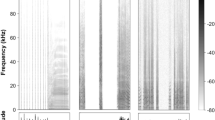Abstract
Seismic communication is known to be utilized in insects, amphibians, reptiles, and small mammals, but its use has not yet been documented in large mammals. Elephants produce low-frequency vocalizations, and these vocalizations have seismic components that propagate in the ground, but it has not yet been demonstrated that elephants can detect or interpret these seismic signals. In this study, we played back seismic replicates of elephant alarm vocalizations to herds of wild African elephants in their natural environment and observed significant behavioral changes indicating that they had detected these signals. Seismic communication may provide an important complement to existing communication modes used by elephants. Seismic sensitivity may also provide elephants with an additional modality for sensing important environmental cues such as changes in weather patterns or seismic disturbances.




Similar content being viewed by others
References
Cokl A, Virant-Doberlet M (2003) Communication with substrate-borne signals in small plant-dwelling insects. Annu Rev Entomol 48:29–50
Dabelsteen T, McGregor PK, Holland J, Tobias JA, Pedersen SB (1997) The signal function of overlapping singing in male robins. Anim Behav 53(2):249–256
Dublin HT (1983) Cooperation and reproductive competition among female African elephants. In: Wasser SK (ed) Social behavior of female vertebrates. Academic, New York, pp 291–313
Fischer S, Samietz J, Wackers FL, Dorn S (2001) Interaction of vibrational and visual cues in parasitoid host location. J Comp Physiol [A] 187(10):785–791
Gunther R, O’Connell-Rodwell CE, Klemperer S (2004) Seismic waves from elephant vocalizations: a possible communication mode? Geophys Res Lett 31:1–4
Heffner RS, Heffner HE (1982) Hearing in the elephant (Elephas maximus): absolute sensitivity, frequency discrimination, and sound localization. J Comp Physiol Psychol 96:926–944
Heller KG (1995) Acoustic signalling in palaeotropical bushcrickets (Orthoptera: Tettigonioidea: Pseudophyllidae): does predation pressure by eavesdropping enemies differ in the Palaeo- and Neotropics? J Zool (London) 237(3):469–485
Langbauer WR Jr, Payne KB, Charif RA, Rapaport L, Osborn F (1991) African elephants respond to distant playbacks of low-frequency conspecific calls. J Exp Biol 157:35–46
Madsen PT, Wahlberg M, Mohl B (2002) Male sperm whale (Physeter macrocephalus) acoustics in a high-latitude habitat: implications for echolocation and communication. Behav Ecol Sociobiol 53(1):31–41
McComb K, Moss C, Durant SM, Baker L, Sayialel S (2001) Matriarchs as repositories of social knowledge in African elephants. Science 292(5516):491–494
Narins PM, Lewis ER, Jarvis JJUM, O’Riain J (1997) The use of seismic signals by fossorial Southern African mammals: a neuroethological gold mine. Brain Res Bull 44:641–646
O’Connell CE, Hart LA, Arnason B (1999) Response to “elephant hearing”. J Acoust Soc Am 105:2051–2052 [see comments on J Acoust Soc Am 104:1122–1123 (1998)]
O’Connell-Rodwell CE, Arnason B, Hart LA (2000a) Seismic properties of elephant vocalizations and locomotion. J Acoust Soc Am 108(6):3066–3072
O’Connell-Rodwell CE, Rodwell T, Rice M, Hart LA (2000b) The modern conservation paradigm: can agricultural communities co-exist with elephants? (Five-year case study in East Caprivi, Namibia). Biol Conserv 93:381–391
O’Connell-Rodwell CE, Hart LA, Arnason BT (2001) Exploring the potential use of seismic waves as a communication channel by elephants and other large mammals. Am Zool 41(5):1157–1170
Oliveira RF, McGregor PK, Latruffe C (1998) Know thine enemy: fighting fish gather information from observing conspecific interactions. Proc R Soc Lond B Biol Sci 265(1401):1045–1049
Payne KB, Langbauer WR Jr, Thomas EM (1986) Infrasonic calls of the Asian elephant (Elephas maximus). Behav Ecol Sociobiol 18:297–302
Peake TM, Terry AMR, McGregor PK, Dabelsteen T (2002) Do great tits assess rivals by combining direct experience with information gathered by eavesdropping? Proc R Soc Lond B Biol Sci 269(1503):1925–1929
Poole JH, Payne K, Langbauer WR Jr, Moss CJ (1988) The social contexts of some very low frequency calls of African elephants. Behav Ecol Sociobiol 22:385–392
Puria S, Allen JB, Elko GW, Jeng PS, Kirkegaard DL (1993) Measurements and analysis with SYSid. J Acoust Soc Am 93:2356
Randall JA, Matocq MD (1997) Why do kangaroo rats (Dipodomys spectabilis) footdrum at snakes? Behav Ecol 8(4):404–413
Rasmussen LEL, Munger BL (1996) The sensorineural specializations of the trunk tip (finger) of the Asian elephant, Elephas maximus. Anat Rec 246:127–134
Reuter T, Nummela S, Hemilea S (1998) Elephant hearing. J Acoust Soc Am 104:1122–1123 (letter)
Stowe MK, Turlings TCJ, Lougrin JH, Lewis WJ, Tumlinson JH (1995) The chemistry of eavesdropping, alarm, and deceit. Proc Natl Acad Sci U S A 92(1):23–28
Sturzl W, Kempter R, van Hemmen JL (2000) Theory of arachnid prey localization. Phys Rev Lett 84(24):5668–5671
White JE (1965) Seismic waves: radiation, transmission and attenuation. McGraw-Hill, New York
Xitco MJ Jr, Roitblat HL (1996) Object recognition through eavesdropping: passive echolocation in bottlenose dolphins. Anim Learn Behav 24(4):355–365
Zwicker E, Feldtkeller R (1999) The ear as a communication receiver. American Institute of Physics, New York
Acknowledgements
We would like to acknowledge the National Geographic Society, US Fish and Wildlife Service, the Seaver Institute, Stanford University’s Morrison Institute and Bio-X Interdisciplinary Research award, as well as University of California at Davis internal grants. We would also like to acknowledge the Namibian Ministry of Environment and Tourism, particularly Pauline Lindeque for supporting the project, Conrad Brain for his field assistance, and Ginger Mauney for her logistical support. We thank the Namibia Nature Foundation for ground and administrative support in Namibia. We thank Heinrich Steuber of SolTec, c.c., in Windhoek, Namibia for his generous support. We also acknowledge the videography of Lianna Jarecki, the statistical consultation of Neil Willits, software advice of Joe Olson, and technical support of John McCormack of Rainbow Electronics and Marvin Clamme of The Guitammer Company. We thank Denise Nicholas for her input on video analysis. We would also like to thank Ben Hart, Karen McComb, and Don Owings for their helpful comments on earlier manuscripts.
Author information
Authors and Affiliations
Corresponding author
Additional information
Communicated by T. Czeschlik
Rights and permissions
About this article
Cite this article
O’Connell-Rodwell, C.E., Wood, J.D., Rodwell, T.C. et al. Wild elephant (Loxodonta africana) breeding herds respond to artificially transmitted seismic stimuli. Behav Ecol Sociobiol 59, 842–850 (2006). https://doi.org/10.1007/s00265-005-0136-2
Received:
Revised:
Accepted:
Published:
Issue Date:
DOI: https://doi.org/10.1007/s00265-005-0136-2




